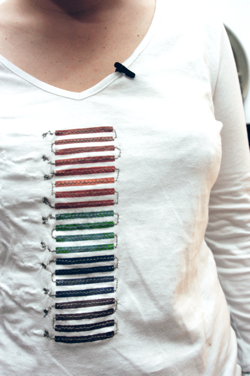A magazine where the digital world meets the real world.
On the web
- Home
- Browse by date
- Browse by topic
- Enter the maze
- Follow our blog
- Follow us on Twitter
- Resources for teachers
- Subscribe
In print
What is cs4fn?
- About us
- Contact us
- Partners
- Privacy and cookies
- Copyright and contributions
- Links to other fun sites
- Complete our questionnaire, give us feedback
Search:
The icebreaker t-shirt

Alan Turing had a lot of talent to shout about, but actually he was pretty shy. Throughout his life he had a reputation for being a little bit awkward in social situations. On the other hand, he kept a small circle of friends around him, and when he had something to talk about he could rise above his shyness.
Confident people can go straight up and introduce themselves to someone they’re interested in getting to know, but for shy people like Turing, this isn't so easy. Making friends is a gradual process of revealing information about yourself, but when we're feeling shy we don't want to expose ourselves to someone new too quickly or too much. Wouldn’t it be nice to have some pointers or clues about the person you're talking to before starting a conversation, to know what to talk about or when to take the leap?
One of the advantages of the Internet is that it can help us to meet new people and connect with others with similar interests. But this doesn't necessarily lead to easier connections in the real world. Nanda Khaorapapong, a PhD student on the Media and Arts Technology programme at Queen Mary, University of London, has been looking at ways to bring some of the benefits of the online world to the real world, and help make these uncertain moments easier.
Designing a computer interface to fit into an everyday situation like meeting someone new poses some interesting problems. The technology has to fit naturally into a situation and it has to be comfortable to use. It must be helpful but not too overwhelming, or else it could take away from the interaction between two people, rather than add to it. After all, she’s trying to make face-to-face contact less awkward and more comfortable for shy people. It seemed like the best way to put all of these ideas together – comfort, helpfulness and friendliness – would be to put the technology in a t-shirt. Her first prototype, the Icebreaker t-shirt, shows two people wearing them how compatible they are after they shake hands with each other.
Nanda began by taking an RFID tag and reader and embeddeding them at one cuff in a long-sleeved t-shirt. A RFID tag is a computer chip with a radio antenna attached, for sending information when it passes near a reader. They’re used in some modern passports, and on London’s public transport system in pay-as-you-go cards. In Nanda’s t-shirt, when two wearers shake hands, the RFID tags can read each other and recognise each other's identity. Next, a mini processor embedded in the shirt calculates compatibility levels between the wearers by matching their favourite film, music, hobbies and other interests. (In the prototype this is programmed in from a questionnaire, but in future it could be calculated on the fly from social networking sites like Facebook.) These compatibility levels are then shown on the shirt front using a display made of heat-sensitive paints and conductive thread. A black bar chart changes when it is heated up based on the compatibility. A colder match comes out blue or green, but for hotter matches between wearers the bars turn yellow, orange or red.
Lots of wearable computers use rigid displays, but Nanda’s soft display means that the t-shirts are still soft and comfy. It's also designed not to give away too much exact information – the colour-coding gives shy users more room to fit the technology to the situation, so they can reveal themselves to others gradually. When Nanda tested her t-shirt with real people doing speed dating, 76% of shy testers said the shirt was helpful when meeting strangers. One said: “It gave a sense of having something in common to begin the conversation, something we both were interested in. Whereas when we didn’t have the shirt, I felt we were only trying to make small talk.”
If you’re occasionally gripped with that awkward feeling around new people, take heart. You’re certainly not alone. In fact, you’ve got some pretty good company in Alan Turing. And hopefully one day, when you meet someone new and interesting you’ll be able to get clues about what to say from some helpful t-shirt technology.


